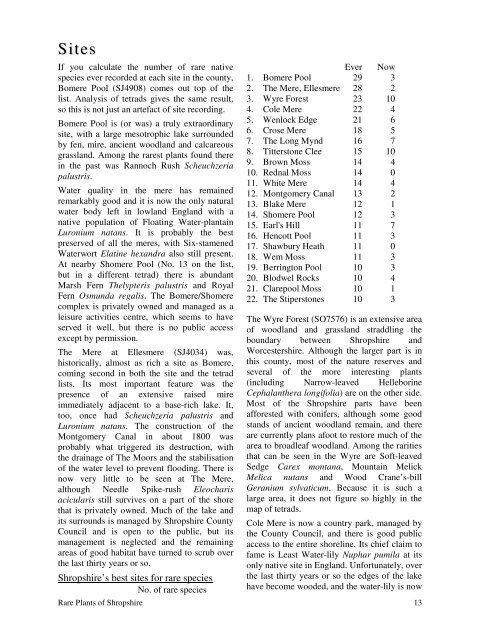Shropshire - Botanical Society of the British Isles
Shropshire - Botanical Society of the British Isles
Shropshire - Botanical Society of the British Isles
- No tags were found...
Create successful ePaper yourself
Turn your PDF publications into a flip-book with our unique Google optimized e-Paper software.
SitesIf you calculate <strong>the</strong> number <strong>of</strong> rare nativespecies ever recorded at each site in <strong>the</strong> county,Bomere Pool (SJ4908) comes out top <strong>of</strong> <strong>the</strong>list. Analysis <strong>of</strong> tetrads gives <strong>the</strong> same result,so this is not just an artefact <strong>of</strong> site recording.Bomere Pool is (or was) a truly extraordinarysite, with a large mesotrophic lake surroundedby fen, mire, ancient woodland and calcareousgrassland. Among <strong>the</strong> rarest plants found <strong>the</strong>rein <strong>the</strong> past was Rannoch Rush Scheuchzeriapalustris.Water quality in <strong>the</strong> mere has remainedremarkably good and it is now <strong>the</strong> only naturalwater body left in lowland England with anative population <strong>of</strong> Floating Water-plantainLuronium natans. It is probably <strong>the</strong> bestpreserved <strong>of</strong> all <strong>the</strong> meres, with Six-stamenedWaterwort Elatine hexandra also still present.At nearby Shomere Pool (No. 13 on <strong>the</strong> list,but in a different tetrad) <strong>the</strong>re is abundantMarsh Fern Thelypteris palustris and RoyalFern Osmunda regalis. The Bomere/Shomerecomplex is privately owned and managed as aleisure activities centre, which seems to haveserved it well, but <strong>the</strong>re is no public accessexcept by permission.The Mere at Ellesmere (SJ4034) was,historically, almost as rich a site as Bomere,coming second in both <strong>the</strong> site and <strong>the</strong> tetradlists. Its most important feature was <strong>the</strong>presence <strong>of</strong> an extensive raised mireimmediately adjacent to a base-rich lake. It,too, once had Scheuchzeria palustris andLuronium natans. The construction <strong>of</strong> <strong>the</strong>Montgomery Canal in about 1800 wasprobably what triggered its destruction, with<strong>the</strong> drainage <strong>of</strong> The Moors and <strong>the</strong> stabilisation<strong>of</strong> <strong>the</strong> water level to prevent flooding. There isnow very little to be seen at The Mere,although Needle Spike-rush Eleocharisacicularis still survives on a part <strong>of</strong> <strong>the</strong> shorethat is privately owned. Much <strong>of</strong> <strong>the</strong> lake andits surrounds is managed by <strong>Shropshire</strong> CountyCouncil and is open to <strong>the</strong> public, but itsmanagement is neglected and <strong>the</strong> remainingareas <strong>of</strong> good habitat have turned to scrub over<strong>the</strong> last thirty years or so.<strong>Shropshire</strong>’s best sites for rare speciesNo. <strong>of</strong> rare speciesEver Now1. Bomere Pool 29 32. The Mere, Ellesmere 28 23. Wyre Forest 23 104. Cole Mere 22 45. Wenlock Edge 21 66. Crose Mere 18 57. The Long Mynd 16 78. Titterstone Clee 15 109. Brown Moss 14 410. Rednal Moss 14 011. White Mere 14 412. Montgomery Canal 13 213. Blake Mere 12 114. Shomere Pool 12 315. Earl's Hill 11 716. Hencott Pool 11 317. Shawbury Heath 11 018. Wem Moss 11 319. Berrington Pool 10 320. Blodwel Rocks 10 421. Clarepool Moss 10 122. The Stiperstones 10 3The Wyre Forest (SO7576) is an extensive area<strong>of</strong> woodland and grassland straddling <strong>the</strong>boundary between <strong>Shropshire</strong> andWorcestershire. Although <strong>the</strong> larger part is inthis county, most <strong>of</strong> <strong>the</strong> nature reserves andseveral <strong>of</strong> <strong>the</strong> more interesting plants(including Narrow-leaved HelleborineCephalan<strong>the</strong>ra longifolia) are on <strong>the</strong> o<strong>the</strong>r side.Most <strong>of</strong> <strong>the</strong> <strong>Shropshire</strong> parts have beenafforested with conifers, although some goodstands <strong>of</strong> ancient woodland remain, and <strong>the</strong>reare currently plans afoot to restore much <strong>of</strong> <strong>the</strong>area to broadleaf woodland. Among <strong>the</strong> raritiesthat can be seen in <strong>the</strong> Wyre are S<strong>of</strong>t-leavedSedge Carex montana, Mountain MelickMelica nutans and Wood Crane’s-billGeranium sylvaticum. Because it is such alarge area, it does not figure so highly in <strong>the</strong>map <strong>of</strong> tetrads.Cole Mere is now a country park, managed by<strong>the</strong> County Council, and <strong>the</strong>re is good publicaccess to <strong>the</strong> entire shoreline. Its chief claim t<strong>of</strong>ame is Least Water-lily Nuphar pumila at itsonly native site in England. Unfortunately, over<strong>the</strong> last thirty years or so <strong>the</strong> edges <strong>of</strong> <strong>the</strong> lakehave become wooded, and <strong>the</strong> water-lily is nowRare Plants <strong>of</strong> <strong>Shropshire</strong> 13
















